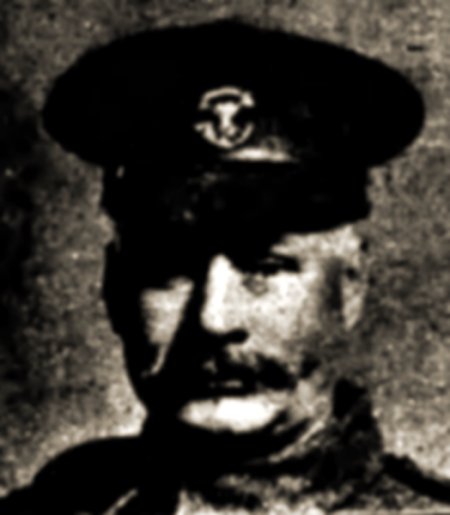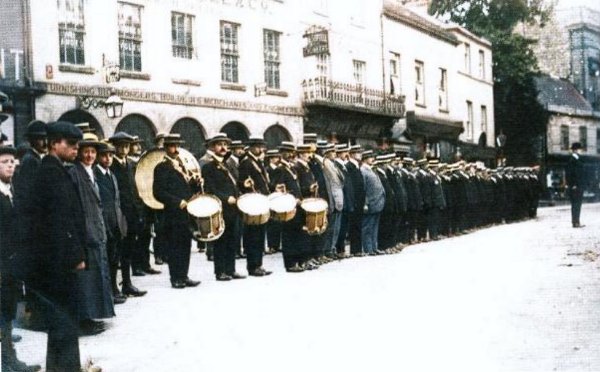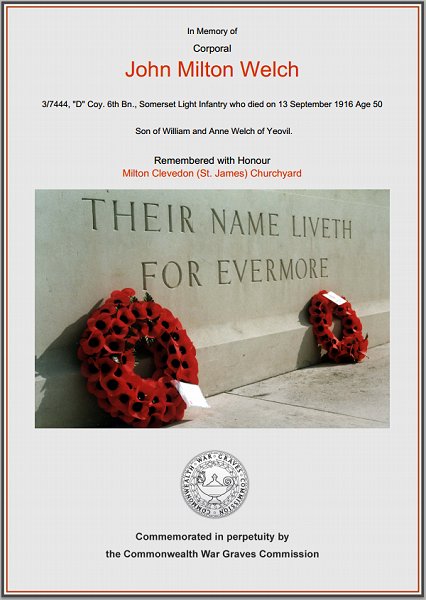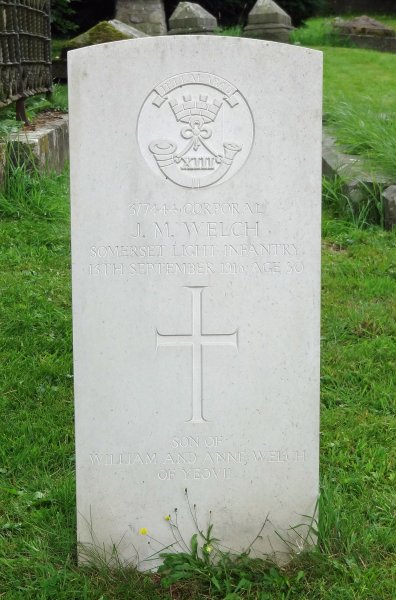yeovil at War
John Milton Welch
The oldest Yeovil soldier killed in the Great War?
John Milton Welch was born in 1866 in Yeovil, the son of chemist, wine merchant and grocer William Welch (1827-19129) originally from Handley, Dorset, and his wife Annie née Caines (1831-1916) from Chilton Cantello. In the 1871 census William and Annie were living above the chemist's shop in High Street with their children: Henry E (b 1859), Emma J (b 1862) and five-year old John. Also living above the shop were a chemist's assistant and a general servant. William and Anne would later have another daughter, Edith Constance (b 1873).
By the time of the 1891 census 24-year old John was lodging in Fisherton Anger, Salisbury, Wiltshire, where he worked as a brewer's clerk. In the autumn of 1893 at Southampton, Hampshire, John married Sarah Ann Barnes (b 1865), originally from the Isle of Wight. In the 1901 census John and Sarah were living at 109 High Street, Southampton. By 1911 John was back in Yeovil, living with his parents and sisters Emma and Edith - there was no sign of Sarah and I haven't been able to trace her after the marriage. John gave his occupation as a clerk at a Political Agency - in fact he worked for the Conservative Association.
 John
had some form of
military service
prior to the
war, most likely
in the
Territorials and
was a member of
the National
Reserve. He
enlisted in the
Army at Yeovil
on the outbreak
of war and became a
Private (Serial
No 3/7444) in D
Company,
6th (Service) Battalion, Somerset Light
Infantry that
was formed in
August 1914.
Bearing in mind
the upper age
for enlisting
was 37 and John
was aged 48, I'm
not sure how
many strings he
had to pull to
enlist.
John
had some form of
military service
prior to the
war, most likely
in the
Territorials and
was a member of
the National
Reserve. He
enlisted in the
Army at Yeovil
on the outbreak
of war and became a
Private (Serial
No 3/7444) in D
Company,
6th (Service) Battalion, Somerset Light
Infantry that
was formed in
August 1914.
Bearing in mind
the upper age
for enlisting
was 37 and John
was aged 48, I'm
not sure how
many strings he
had to pull to
enlist.
The 6th Battalion crossed the Channel on 21 May 1915. They were in billets for the first few weeks and spent their time as working parties digging trenches southwest of Ypres. The 6th Battalion commenced its first tour in the front line on 12 June 1915.
On 26 July 1915, while at Hooge, the Battalion was subjected to a new weapon of war - the flamethrower. This event is described in the Regimental History of the Somerset Light Infantry "Very early in the morning the front-line trenches of the Brigade were suddenly flooded by liquid fire, which belched from jets in the German lines opposite. This new device momentarily caused surprise and confusion, and the victims of this dastardly attack fell back from the front-line trenches which were then occupied by the enemy."
The rest of July and August passed in day-to-day trench warfare with, as the Regimental History points out "Two days in and two days out of the front line was the rule at this period, but between the miserable conditions of the billets and the filthy state of the trenches there was little choice." However in mid-September the 6th Battalion were in preparation for an attack at Bellewaarde, a subsidiary action at Hooge. The attack, on the 25th September, on the trenches held by the Germans in the vicinity of Hooge and Bellewaarde Lake was made with the object of distracting attention from a "full-dress" attempt to break through at Loos, to the south, and to contain the enemy's reserves. Like so many similar attacks, it entailed heavy losses to the attacking infantry. Zero hour was fixed for 4:20am and the preliminary bombardment was to open at 3:50am. The enemy trenches were reached but could not be held but, according to the Regimental History of the Somerset Light Infantry, "The Battalion held on all day in trenches.... with fierce tenacity and splendid courage, held on all day in the face of a terrible bombardment.... About 5pm the enemy's artillery fire gradually became less and by 7pm had almost died down.... In other ranks the Battalion had lost 11 killed, 38 wounded and 3 missing."
The 6th Battalion had been formed at Taunton in August 1914, becoming part of the 43rd Brigade, 14th Division at Aldershot later that year. On 21 May 1915 the 6th Battalion landed at Boulogne, France, and was involved in extensive fighting from that point onwards.
Walter fought with the 6th Battalion throughout the latter part of 1915 and the first half of 1916. In the summer of 1916 the Battalion was involved in the Battle of the Somme, including the Battle of Delville Wood.
On 1 July 1916, supported by a French attack to the south, thirteen divisions of Commonwealth forces launched an offensive on a line from north of Gommecourt to Maricourt. Despite a preliminary bombardment lasting seven days, the German defences were barely touched and the attack met unexpectedly fierce resistance. Losses were catastrophic and with only minimal advances on the southern flank, the initial attack was a failure. In the following weeks, huge resources of manpower and equipment were deployed in an attempt to exploit the modest successes of the first day.
However, the German Army resisted tenaciously and repeated attacks and counter attacks meant a major battle for every village, copse and farmhouse gained. The Battle of Delville Wood, fought between 14 July and 3 September, was an engagement in the 1916 Battle of the Somme in which the 6th Battalion, Somerset Light Infantry, was deeply involved. Delville Wood is to the north east of the town of Longueval in the département of the Somme in northern France.
After the two weeks of carnage from the commencement of the Somme Offensive, it became clear that a breakthrough of either the Allied or German line was most unlikely and the offensive had evolved to the capture of small prominent towns, woods or features which offered either side tactical advantages from which to direct artillery fire or to launch further attacks.
Delville Wood was one such feature, making it important to German and Allied forces. As part of a large offensive starting on 14 July, General Douglas Haig, Commander of the British Expeditionary Force, intended to secure the British right flank, while the centre advanced to capture the higher lying areas of High Wood in the centre of his line. Delville Wood was a battle to secure this right flank. The battle achieved this objective and is considered a tactical Allied victory. However, it was one of the bloodiest confrontations of the Somme, with both sides incurring large casualties.
According to the Regimental History of the Somerset Light Infantry, after the first phase of the Battle of Delville Wood, the 6th Somersets had spent several days in billets in Fricourt. During August the battalion was involved in the taking of Hop Alley and Beer Trench adjoining Delville Wood. After much heavy fighting the whole of Hop Alley passed into the hands of the Somerset men. Following the fighting, according to the Regimental History, "They dug a new CT (communication trench) under heavy fire and did it quickly and well. Also carried wire, stakes, etc, to the front line. Sent back 82 prisoners under escort. Carried bombs and sandbags. Put up artillery boards. Sent 20 men to fill gap on our left. Sent 20 men to make and hold a strong point in gap between right companies. Sent 30 men to support C company in Hop Alley. And then, when night had fallen, the remainder of this gallant company carried bombs, SAA, water, etc. to the front line." The Regimental History continues "A little later (at 5pm) officers of the 9th Rifle Brigade came to look round the trenches of the 6th Somersets and made arrangements for taking them over. Hostile shelling, however, prevented the relief taking place until almost midnight, but this was all to the advantage of the Somerset men, who had no casualties in coming out of the line. The relief was completed at 4:15am, the battalion being billeted in Fricourt. "The men," stated the Battalion Diary, "on arrival in rest billets, were absolutely beat; the authorities had wisely kept them until the last possible moment and then taken them out." Thus ended another phase of the Battle of Delville Wood, a phase which cost the regiment five officers killed and seven wounded, with 48 other ranks killed and 220 wounded and missing. On 22 August the Brigade was paraded and the Brigadier complimented the 6th Somersets especially on the fine behaviour of the Battalion in Delville Wood."
It would seem likely that John Welch, by now a Corporal, was wounded in this action. He was shot in the head and suffered a fractured skull. He was returned to England and sent to the Royal Victoria Hospital, which was a large military hospital at Netley, near Southampton, Hampshire. John Welch died from his wounds in the hospital on 13 September 1916. He was aged 50.
On 22 September 1916, the Western Gazette reported "The relatives of Corporal JM Welch have received the sad information that he has succumbed to wounds received in action. Corporal Welch, who was in Netley Hospital was previously reported seriously wounded, being shot in the head, and suffering from a fractured skull. Although ineligible for military service (being over fifty years of age) Corporal Welch had been in France for 15 months and was one of the first when war was declared to enlist in the National Reserve Battalion of the Somerset Light Infantry which Regiment has taken part in some of the severest fighting. Corpl. Welch was one of the clerical staff of the Conservative Association. His death will be keenly felt by townspeople as he was so well known in the town. The body was moved to Milton Clevedon, near Evercreech, to await burial which took place on Saturday. A short choral service was held in the church prior to the interment. The inscription on the coffin read “Corporal J.M Welch, 6th Somerset LI, died of wounds received in action, September 13th 1916, aged 50.”
John Welch was interred in Milton Clevedon (St. James) Churchyard, near Evercreech, and his name is recorded on the War Memorial in the Borough.
gallery

John Milton Welch, reproduced from a newspaper.

On Bank Holiday Monday, 4 August 1914, Yeovil men of 'E' (Yeovil) Company, 1st (West) Somerset Battalion of the National Reservists, known colloquially as the 'Straw Hat Brigade', line up in the Borough before marching to the Town Railway Station and travelling to Taunton. War was declared at midnight. John is almost certainly in this photograph.

The Commonwealth War Graves Commission certificate in memory of John Welch.

John Welch's headstone in Milton Clevedon (St. James) Churchyard, near Evercreech